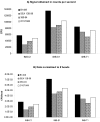Capture of Escherichia coli O157:H7 Using Immunomagnetic Beads of Different Size and Antibody Conjugating Chemistry
- PMID: 22399935
- PMCID: PMC3280827
- DOI: 10.3390/s90200717
Capture of Escherichia coli O157:H7 Using Immunomagnetic Beads of Different Size and Antibody Conjugating Chemistry
Abstract
Immunomagnetic beads (IMB) were synthesized using anti-Escherichia coli O157 antibodies and magnetic beads of two different sizes (1 μm and 2.6 to 2.8 μm) that contained a streptavidin coating, activated carboxyl groups or tosylated surfaces. The synthesized IMB, together with a commercially available IMB, were used to capture different strains of E. coli O157:H7 and E. coli O157:NM. The E. coli capture was measured by the time resolved fluorescence (TRF) intensity using a sandwich assay which we have previously demonstrated of having a sensitivity of 1 CFU/g after 4.5 hour enrichment [1]. The analyses of measured TRF intensity and determined antibody surface concentration indicated that larger beads provided higher response signals than smaller beads and were more effective in capturing the target of interest in pure culture and ground beef. In addition, while each type of IMB showed different favorable capture of E. coli O157:H7, streptavidin-coated IMB elicited the highest response, on average. Streptavidin-coated IMB also provided an economic benefit, costing less than $0.50 per assay. The results could be used to guide the proper choice of IMB for applications in developing detection processes for E. coli O157:H7.
Keywords: Escherichia coli; antibody linkage; immunomagnetic beads; time-resolved fluorescence.
Figures




References
-
- Tu S.-I., Golden M., Andreotti P., Yu L.S.L., Irwin P. Applications of time-resolved fluoroimmunoassay to detect magnetic bead captured Escherichia coli O157:H7. J. Rapid Meth. Autom. Microbiol. 2001;9:71–84.
-
- Centers for Disease Control and Prevention Ongoing multistate outbreak of Escherichia coli serotype O157:H7 infections associated with consumption of fresh spinach – United States, September 2006. Morb. Mortal. Wkly. Rep. 2006;55:1045–1046. - PubMed
-
- Centers for Disease Control and Prevention Outbreak of Salmonella serotype Saintpaul infections associated with multiple raw produce items – United States. Morb. Mortal. Wkly. Rep. 2008;57:929–934. - PubMed
-
- U.S. Department of Agriculture, Food Safety and Inspection Service Microbiology Laboratory Guidebook Online. 2008. Section 5.04; http://www.fsis.usda.gov/Science/Microbiological_Lab_Guidebook/index.asp.
-
- U.S. Food and Drug Administration Bacteriological Analytical Manual Online. 2002. Chapter 4a. http://www.cfsan.fda.gov/~ebam/bam-4a.html.
LinkOut - more resources
Full Text Sources
Other Literature Sources

